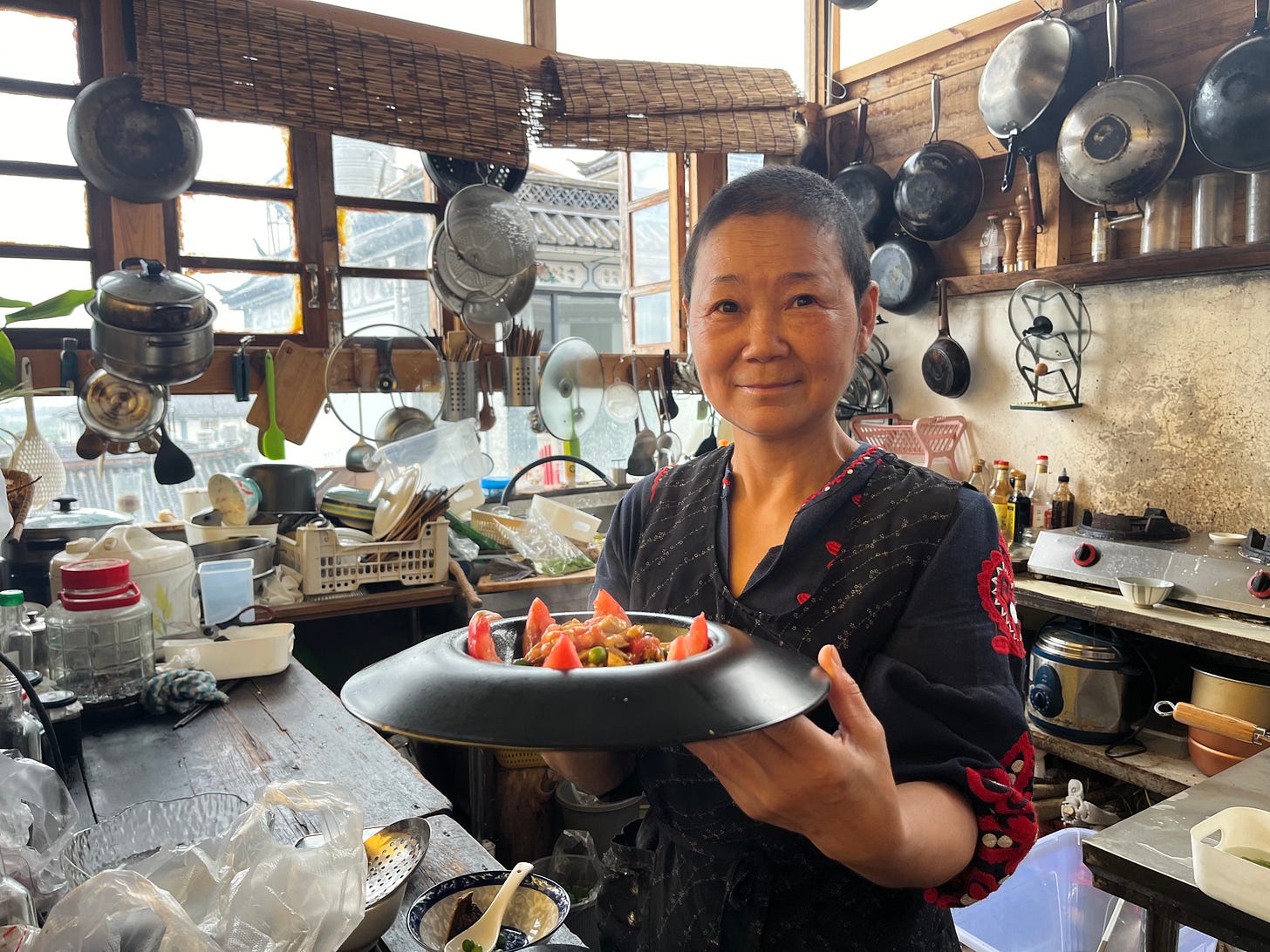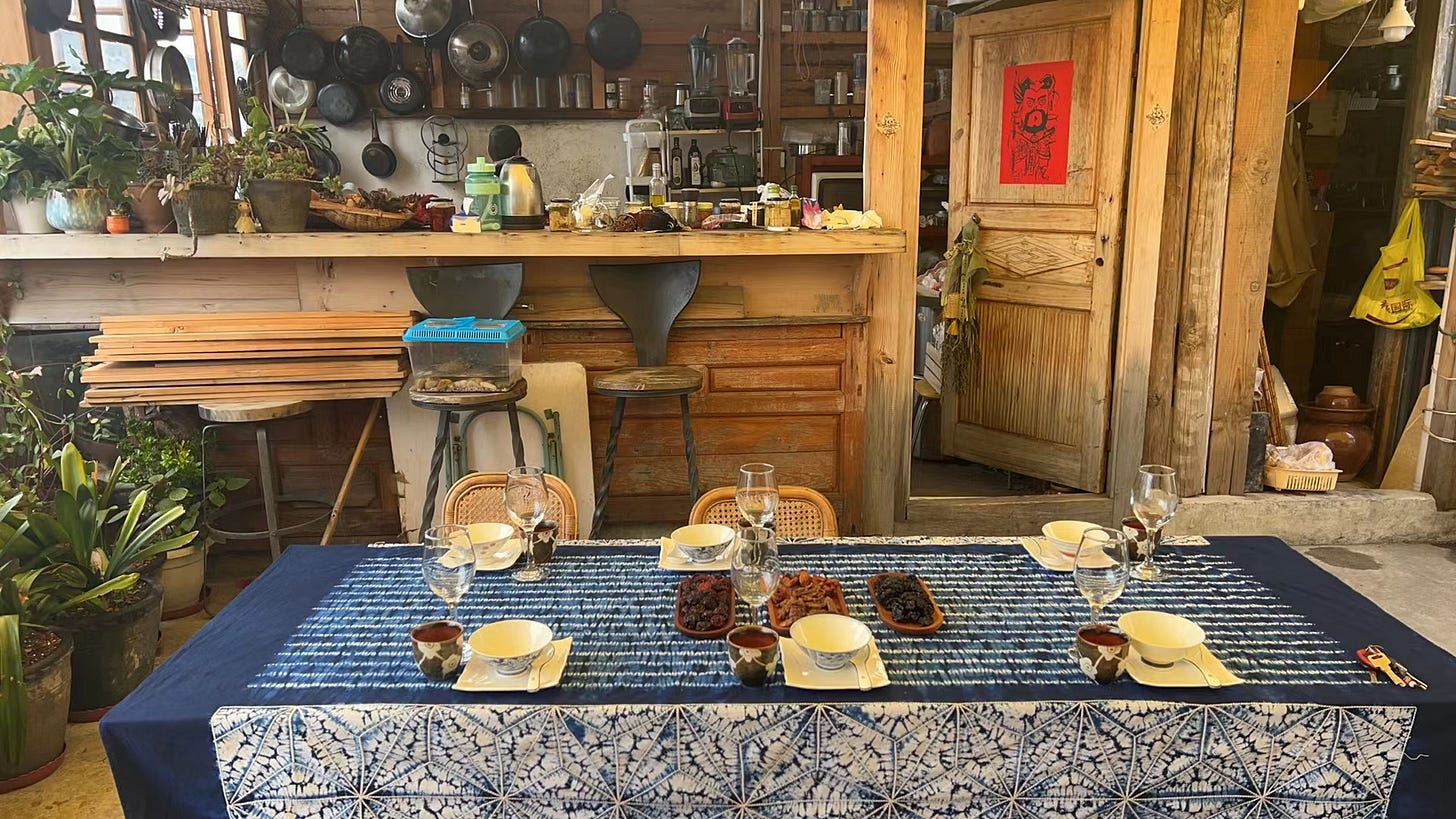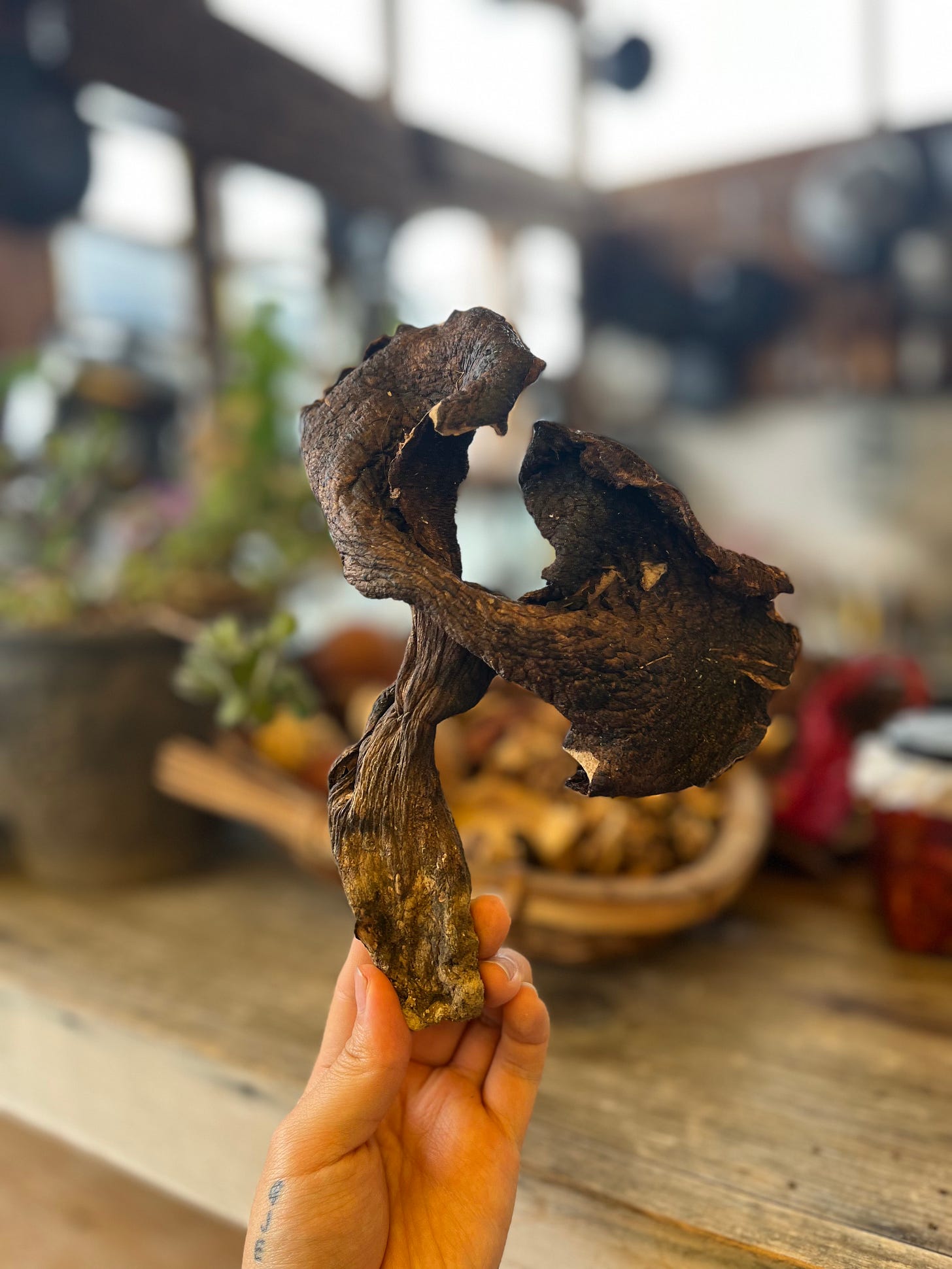(Read Pt. 1 of Chefs in Yunnan: A foraged vegan dinner in a 130-year-old house)
Chef Guohe embodies her name Chuntian Jiejie (春天姐姐), a nickname that means Spring Sister. She’s soft-spoken, with a gentle radiance and unhurried warmth that spills out of her like sunlight. I’d sit in her kitchen all day if I could. Three years ago, she started her private restaurant (私厨) in her home in Three Pagodas village in Dali. I had heard about her food for months and finally booked a reservation last Thursday with five friends.
“Welcome to my courtyard in the sky,” Chuntian Jiejie said. Seated at the low table, we could see the rolling peaks of Cangshan mountain to the left and the rain-darkened sea to the right. I’d been running late that morning, hair damp after rain and mind on the edge of frazzle, but when I emerged from the stairs into the open-air courtyard I thought I’d walked into a film. Everyone sat sipping tea and eating dried dates and apples like they’d been there forever. Up here, at elevation 6800 feet, time felt suspended.
Chuntian Jiejie had spread an indigo-dyed tablecloth set with wine glasses, not for wine (she doesn’t serve alcohol) but for the hibiscus tea. “You can see the beautiful color in the glass,” she said simply. There was something special about sitting outside, with the fog rolling in above the mountains like a blanket, the smell of frying food in the chilly air. A clenched knot loosened in the pit of my stomach. Suddenly I felt hungry.
The Appetizers

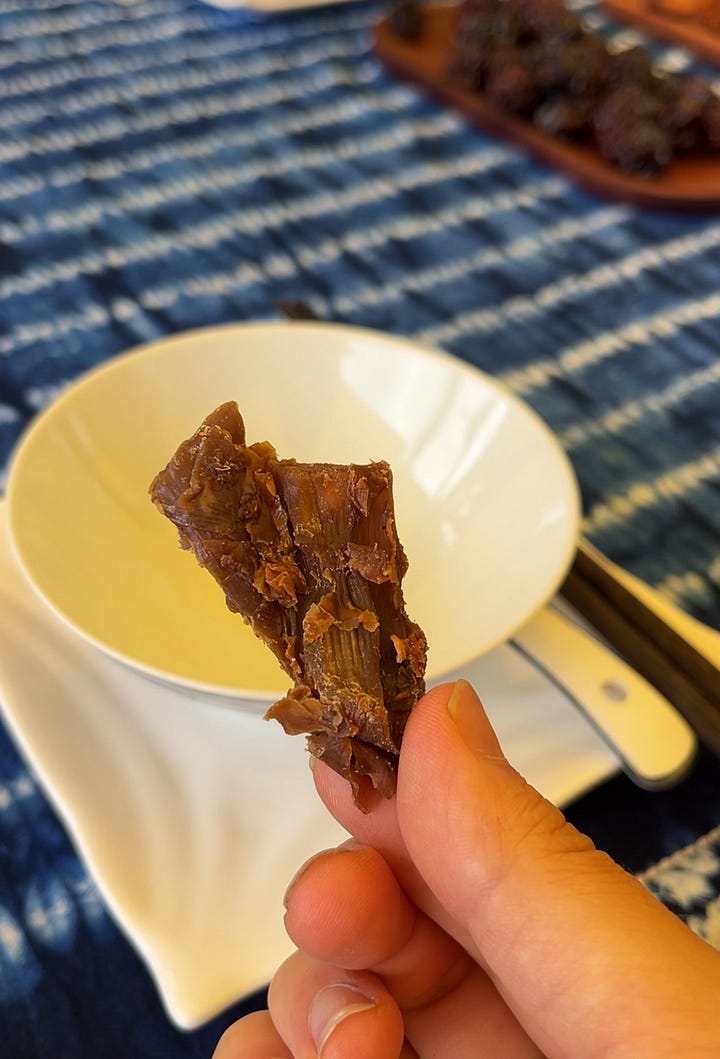
We started with black and red dates, sun-dried until chewy like taffy, and slices of dried Xinjiang apples and bamboo shoots. The bamboo shoots had been marinated in a caramel soy sauce before drying, and they were sweet and almost candied, like barbecue-flavored jerky. I could chew on these for a long time, the texture was engrossing.
Chuntian Jiejie placed the first appetizer on our table: shards of onion-purple napa cabbage floating in pickled green plum and mint brine (梅子 meizi). Surrounded by fallen pine needles, it looked like something you’d find on a forest floor. The dressing was sharp and minty and a little tart, like ume vinegar.

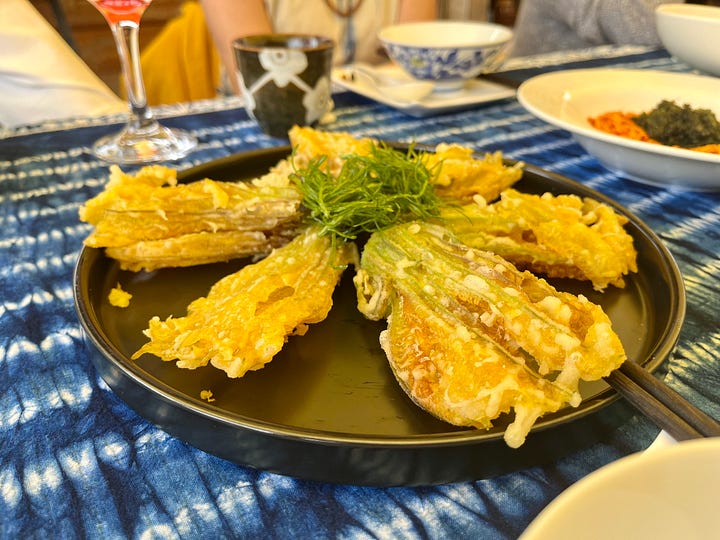
Most chefs would serve fried squash blossoms with a sauce, or stuff it with something creamy, relegating the vessels themselves to a texture, a fried crunch. But here, the tempura-battered pumpkin flowers were lightly seasoned with salt and I could actually taste their flavor, sweet and slightly herbal. It was perfect with more pine, this time fried into feathery wisps.
The next appetizer: fried astragalus (黄芪 huangqi), resembling wood chips or a mushroom sprouting right there on the dark plate among sprigs of mint. Dry and crunchy as shrimp chips, the flavor of the root surprised me— it wasn’t like a tuber at all, but earthy with a strong medicinal grassiness.

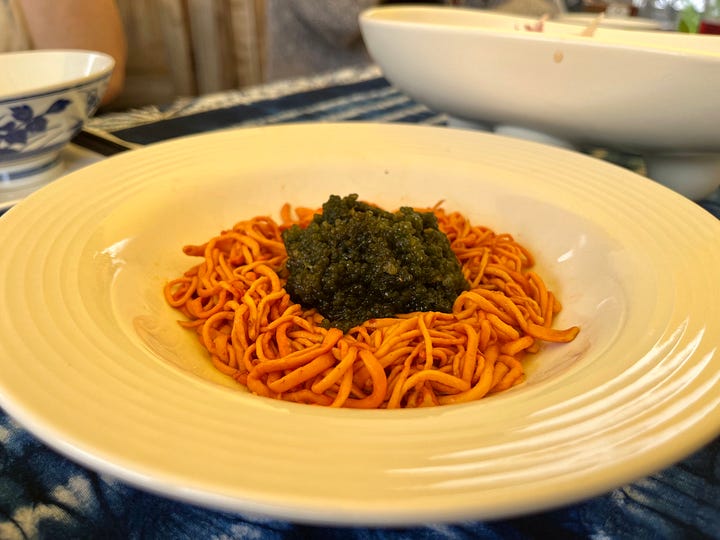
Then there was a bird’s nest of orange cordyceps and sea grapes, popping strands of briny beads dressed with pungent mujiangzi oil (木姜子 Listea pungens) and Sichuan peppercorn oil. A perfect marriage of two peppery berries, one nose-tickling and the other numbing on the tongue.
When the soup arrived I held the bowl in both hands and warmed my fingers before drinking the dark broth. I slowly spooned up the treasures: a firm, crunchy matsutake slice, a jade spear of asparagus, a dark, spongy morel and more candy-colored cordyceps.
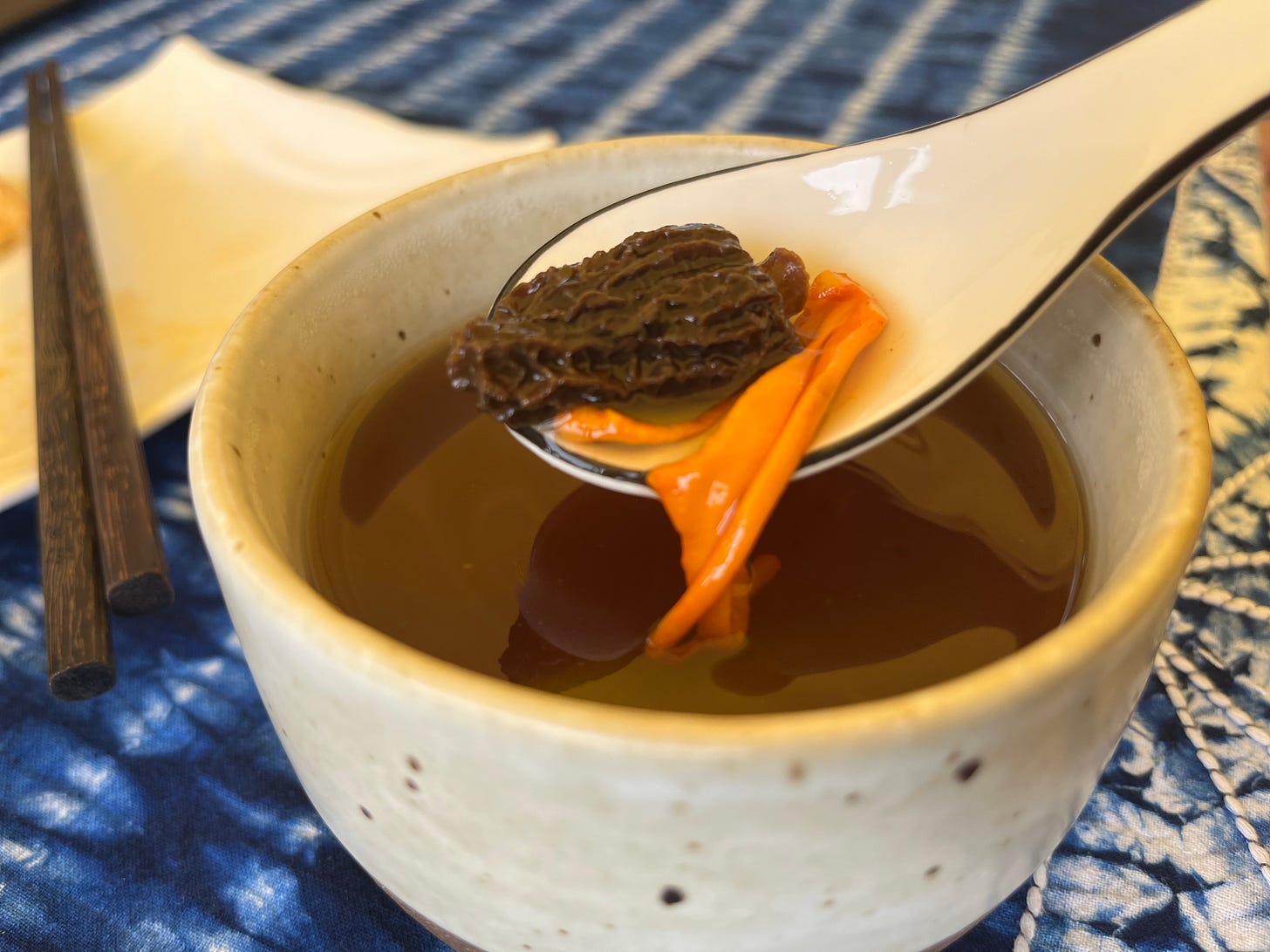

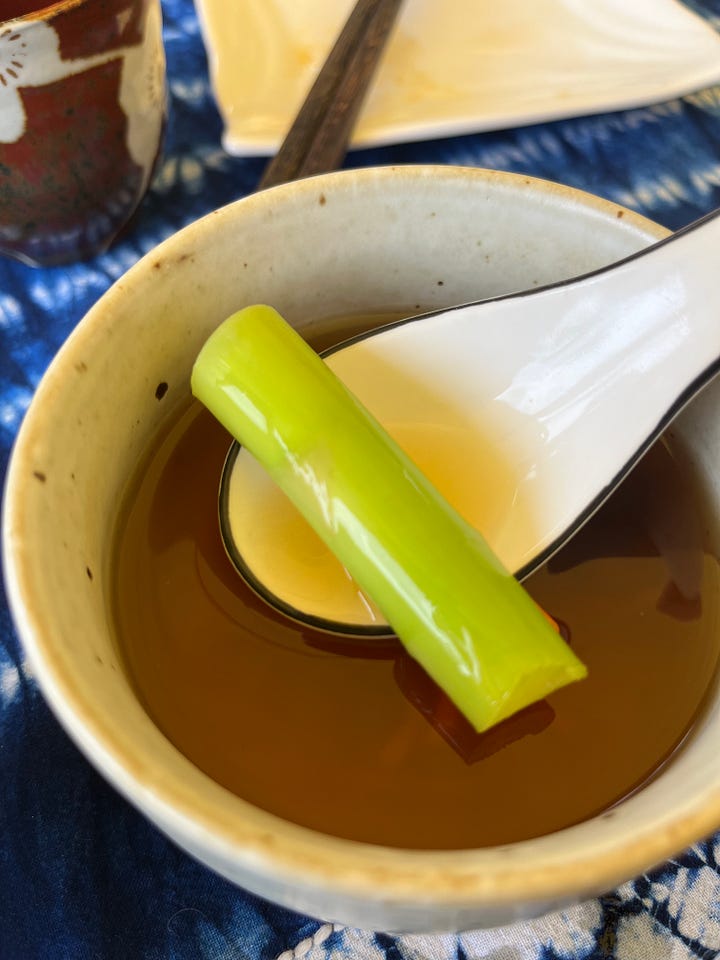
Hot Courses
Next, the mushroom that got us accidentally high.
Jianshouqing (见手青, Lanmaoa asiatica), native to Yunnan province, is a species of boletus that turns blueish green upon bruising or contact. It’s also called red porcini mushroom (红牛肝菌) and similar to the lurid bolete (Suillellus luridus), although not poisonous.
The mushroom is infamous in Yunnan for its hallucinogenic compounds, which may or may not be removable by cooking. Locals here eat it regularly and advise to cook it at least thirty minutes to be safe, but a few people still end up in the hospital every year with visions of little dancing men (xiao ren ren). Chuntian Jiejie said she cooked these for an hour. Currently, no one knows what exactly in the mushrooms causes these hallucinations, but it’s different from those found in psilocybin mushrooms.
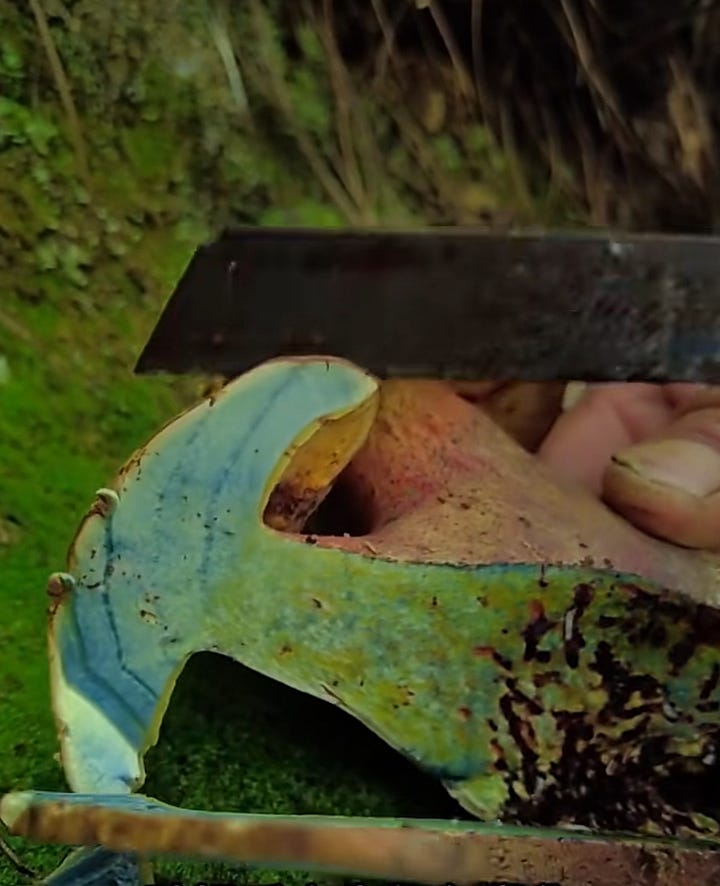

When the dish arrived we all looked at it for a few minutes, wondering what the fuss was about— the jianshouqing were halved, resting innocent as buttons on tongues of bamboo shoots. I didn’t think the flavor was that different from a regular porcini mushroom: meaty, slippery, and slightly crunchy. We each ate one piece per person and moved on.
My favorite was actually the bamboo slices underneath, a Yunnan varietal called “sugarcane bamboo,” prized for its exceptionally sweet and crisp texture. Chuntian Jiejie had also plucked a few chrysanthemum head greens (Chrysanthemum indicum) from her potted plant for a lovely, slightly bitter garnish.
About twenty minutes we all started feeling something. My Chinese friend was flushed and giggling. I started snapping photos of the mountains, enamored by the colors. “Did the sunlight just get brighter, or is that me?” someone else said.
Only a few of us in the group knew what a weed high felt like (cannabis use is still illegal in China), and my European friend looked at each other and started laughing uncontrollably. Some explanations were in order. These weren’t hallucinogenic after all— the effect to my brain felt similar to THC but without any of the sluggishness. Just a profound feeling of well-being. It lasted about an hour for me, and my friends reported their high fading by the end of the afternoon. (Jianshouqing was even in the news last year after the US Treasury Secretary ate them on a visit).
Scientists still can’t pinpoint what compound in these porcini causes these effects, and all the evidence so far is still anecdotal, so ordering this at a restaurant is a “generally harmless with a small thrill of mystery” kind of situation. Chuntian Jiejie cleared our plates and didn’t suspect a thing.
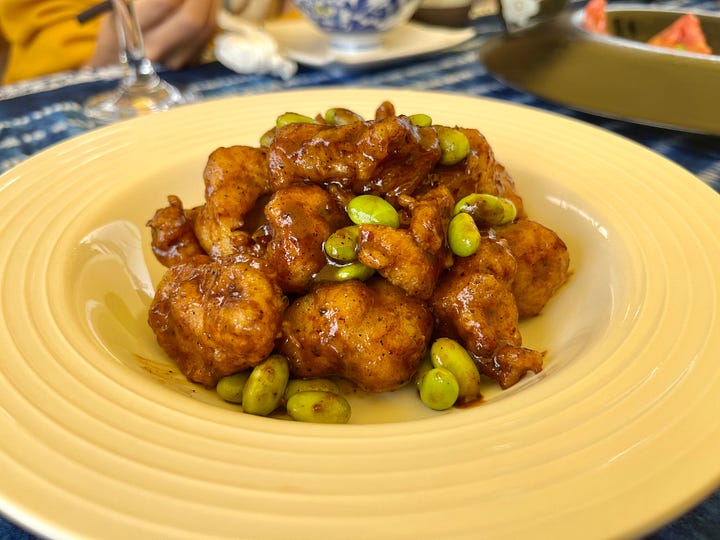
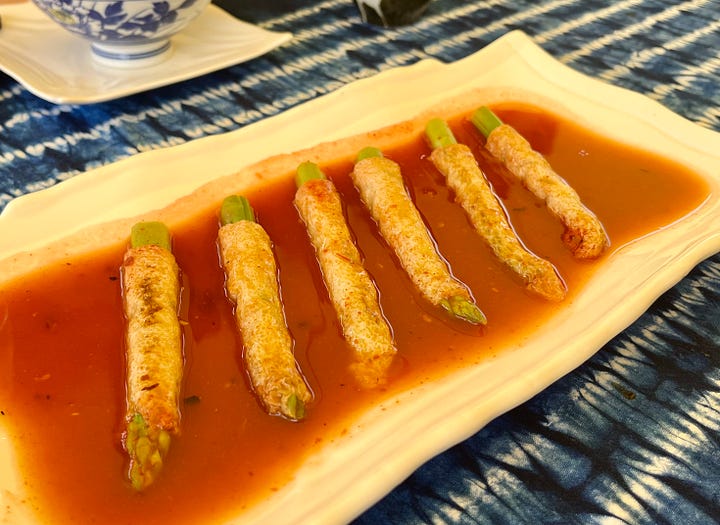
The next two dishes featured more familiar mushrooms: dried lion’s mane mushroom (Hericium erinaceus), soaked, squeezed dry, fried, and glazed in a sweet and sour sauce, in Northeast guobaorou style but with the addition of black pepper. This was stellar.
Next, crisp spears of asparagus wrapped in cashmere sweaters of bamboo fungus, resting in a tomato sauce that reminded me a lot of the sour fermented tomato hot pot broth I had in Guizhou (红酸汤).
This dish was my favorite. On the plate the black tiger paw’s mushrooms (虎掌菌 huzhangjun) looked burnt, like charred scallions, or a pile of tea leaves discarded after a steep. But they were oily and flavorful, dried mushrooms that Chuntian Jiejie had slow-roasted in oil until they’d taken on the fat and chew of meat. Each tiny piece flooded my tastebuds with umami. We finished off the mushrooms within minutes, enjoying the alternating crunch of ivory grass shoot fingers (草芽 caoya) and green pumpkin stems (南瓜藤 nanguateng).
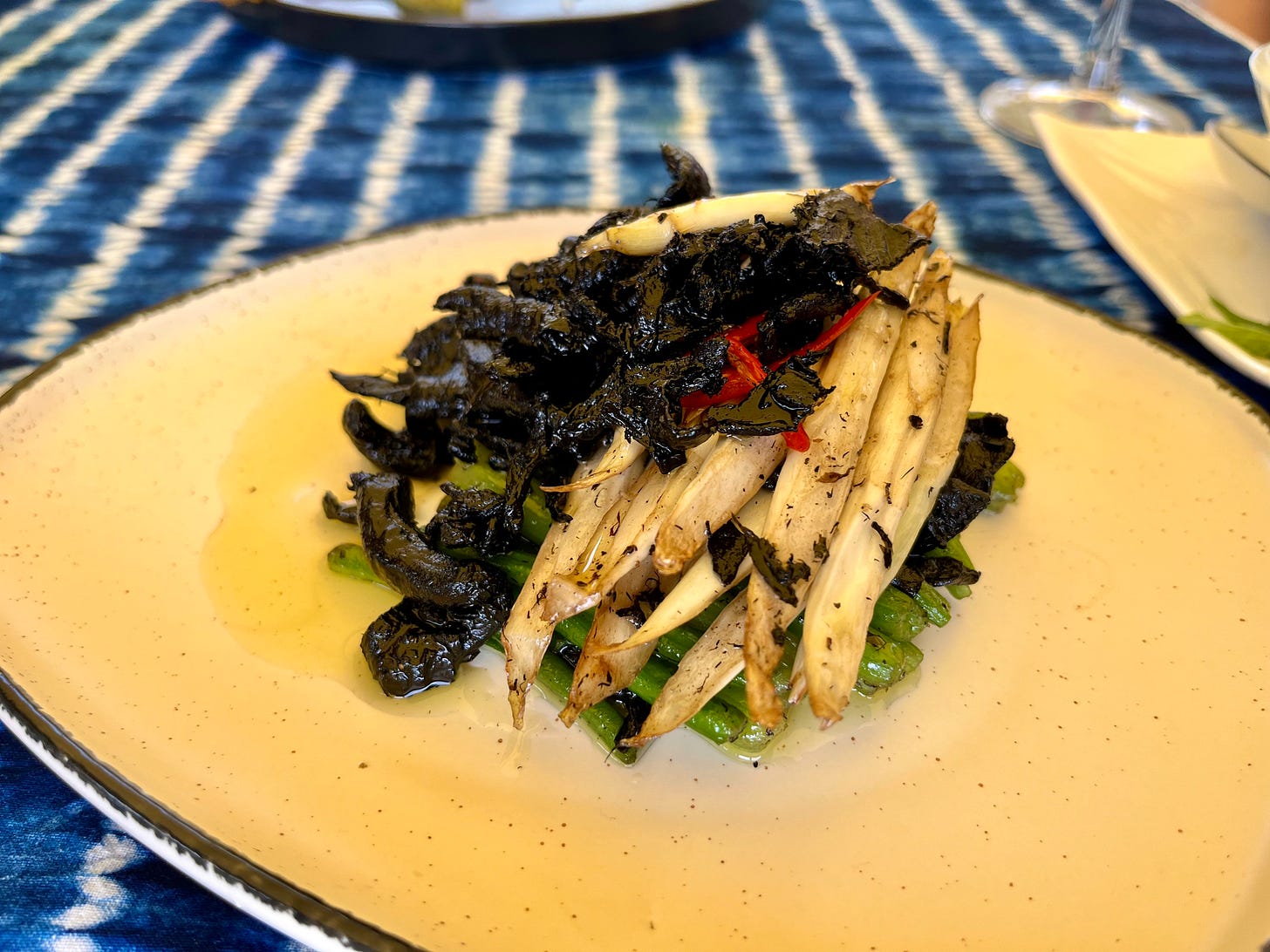
The next course featured red porcini (美味牛肝菌 meiwei niuganjun). This variety of boletus is native to Yunnan and abundant in the markets right now. I snapped a photo the other day of some massive ones.
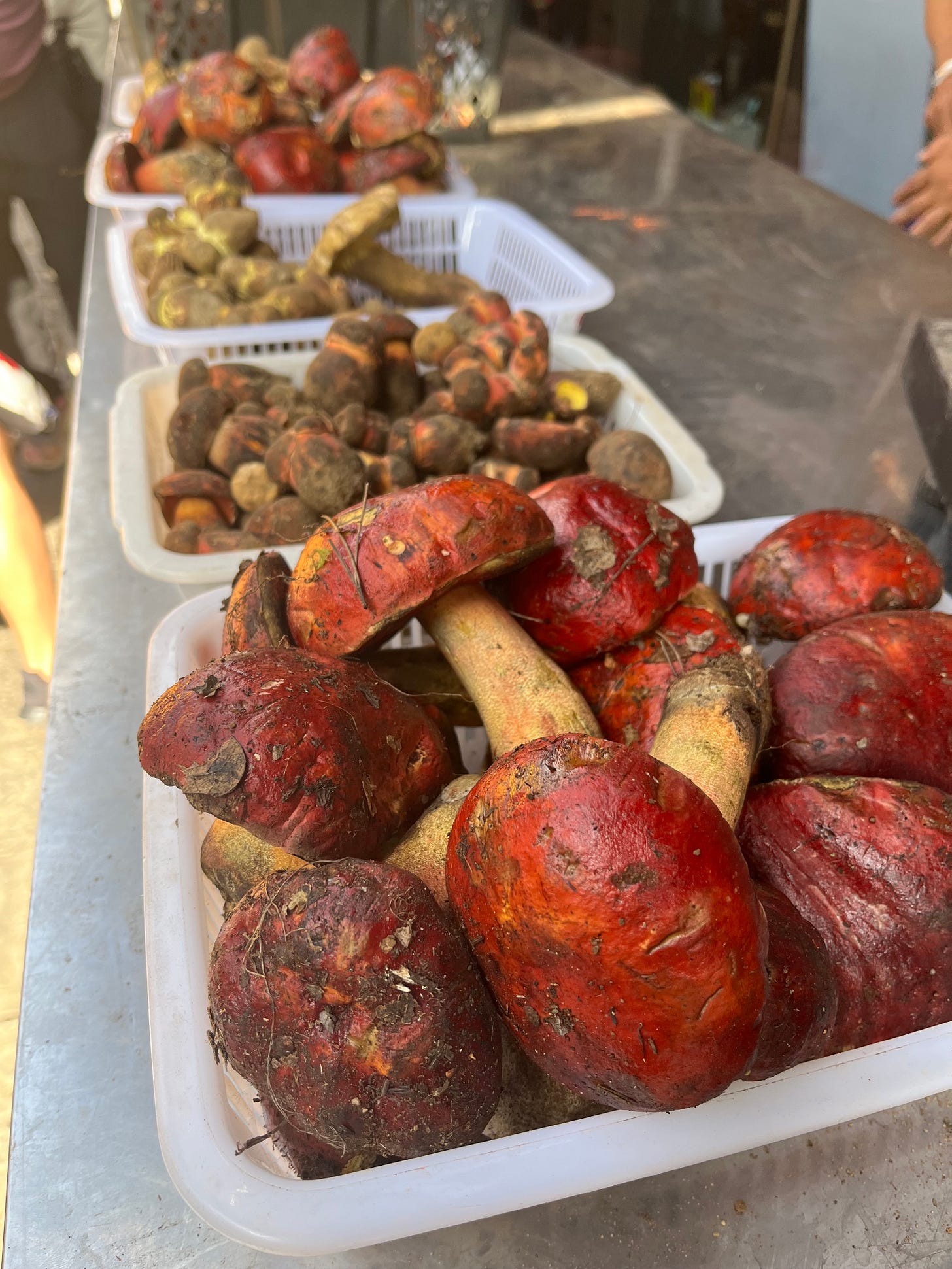
Chuntian Jiejie stir-fried the porcini with tomato and green peas, and the aroma was wonderfully smoky and laced with wok hei. The tomato had been blanched and peeled and sliced open into a flower. Like a beautiful offering.

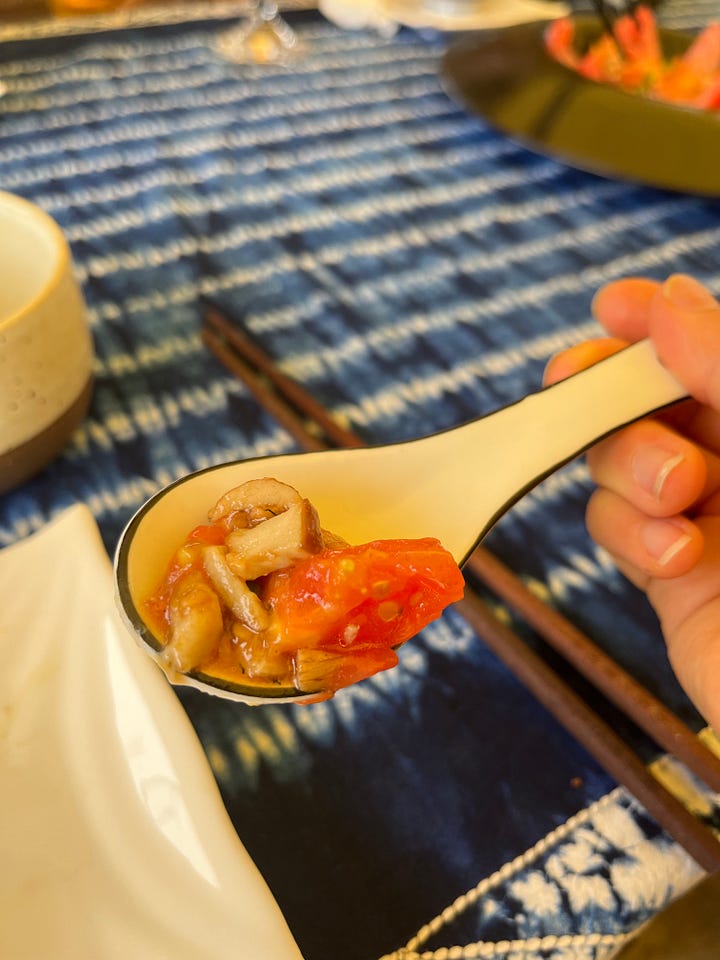
Yunnan yellow porcini is milder in flavor but with the texture of e-gan (鹅肝) or goose liver (foie gras), soft and velvety. It’s also called 沉香菌 chen xiang jun or 黄牛肝菌 huang niu gan jun. Chuntian Jiejie said it’s a less valuable mushroom because of its water content, but she likes to pair it with shiso leaf, simply seared and seasoned with salt.

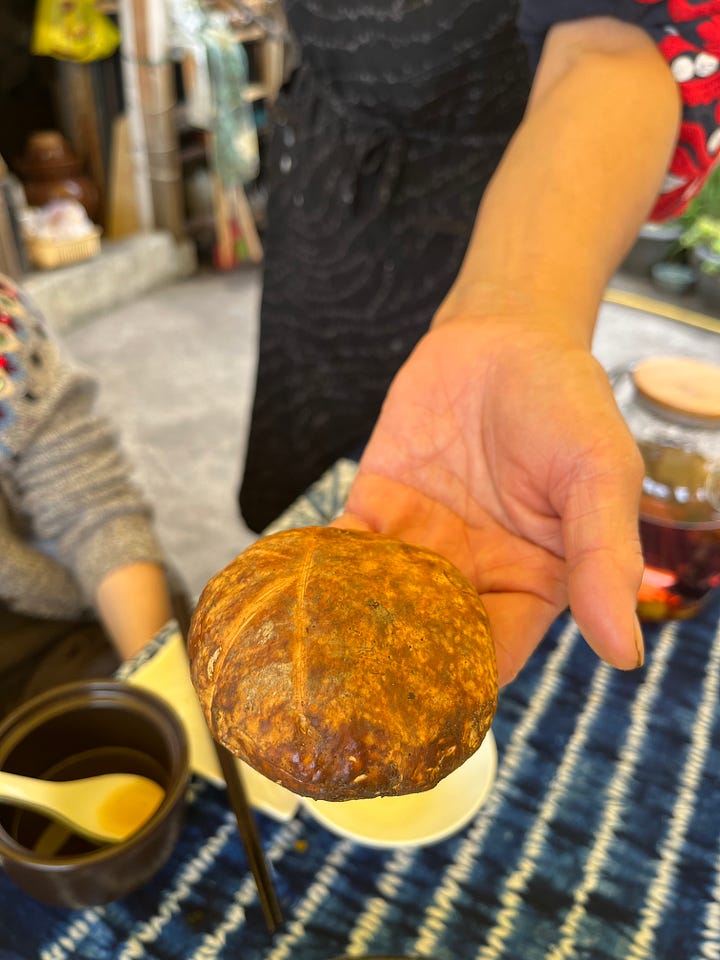
In China the starch arrives last. We finished our meal with wolf’s-teeth white rice (狼牙米 langyami) steamed to a perfect chew and dotted with quinoa and fox nuts, (芡实 qianshi), white wood-ear (白玉木耳 baiyu mu-er) and more green soybeans, spilling from a kabocha squash.

The meal cost 188 yuan ($26 USD) per person. 12 courses, ten different mushrooms.
The Menu
Cordyceps (Cordyceps sinensis), sea grapes, mujiangzi oil, Sichuan peppercorn oil 虫草花拌海葡萄 ,木姜子花椒油
Fried huangqi (Astragalus mongholicus), mint 香炸黄耆
Pine needle tips, purple napa cabbage, mint and green plum pickling brine 紫白菜拌松针,薄荷梅子露
Fried pumpkin blossoms, pine needle tips 松针南瓜花
Soup: Matsutake (Tricholoma matsutake), morel, asparagus, and cordyceps mushroom 松茸芦笋黄芪汤
Jianshouqing (Lanmaoa asiatica), rice shoots, chrysanthemum tops 见手青炒云南天笋,自己种的菊花脑
Lion's mane mushroom (Hericium erinaceus), sweet and sour sauce, black pepper 虎掌菌炒草芽和南瓜藤
Bamboo pith fungus (Phallus indusiatus), asparagus, fermented tomato sauce 黄牛肝菌紫苏叶
Dried tiger's paw mushroom (Lignosus rhinocerus), grass shoots, asparagus 西红柿炒牛肝菌
Yunnan red porcini (Boletus pinophilus), tomato, green soybeans 锅包猴头菇
Yunnan yellow porcini (Boletus edulis), shiso leaf, peas 竹荪包芦笋
Wolf's teeth rice, white wood-ear (Tremella fuciformis), quinoa, fox nut, kabocha squash 狼牙米饭(白玉木耳,南瓜,藜麦,芡实)
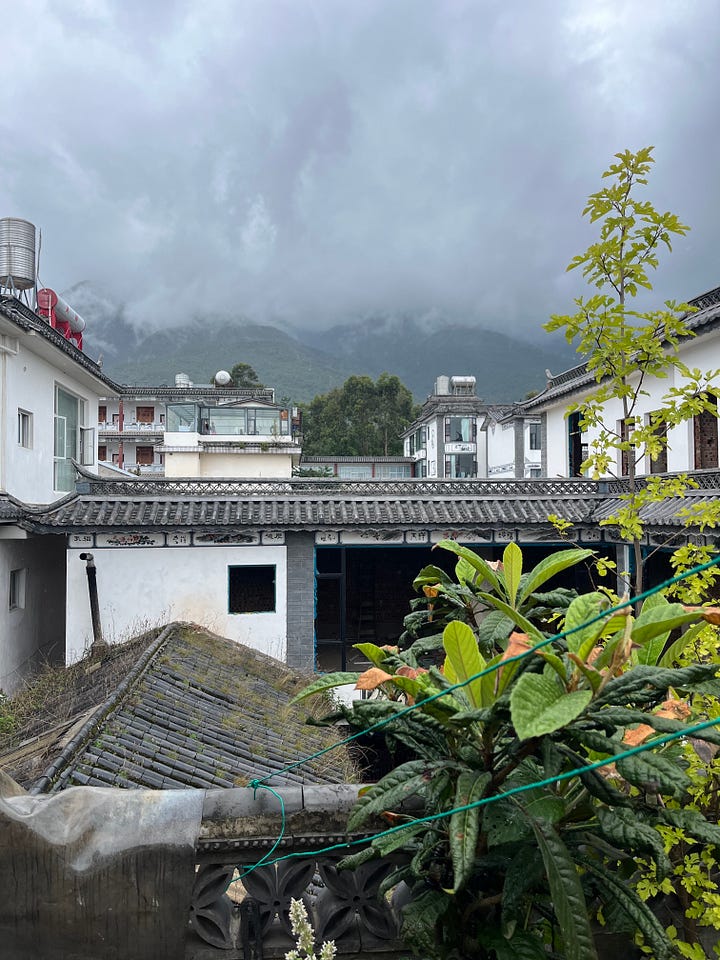
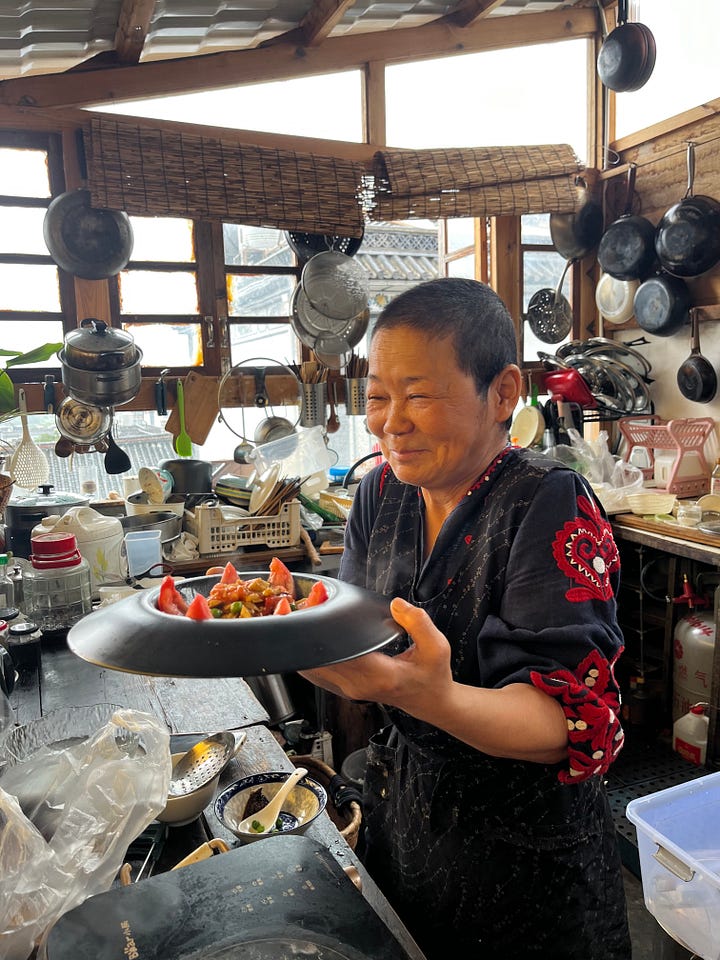
How long have you been a vegetarian chef?
I started to cook and eat only vegetarian after I moved to Dali four years ago to be with my daughter and sister. My sister is a devout Buddhist and I would often cook for her and her guests. Many people would ask to reserve meals, so after I moved to this courtyard, I decided to set up my own kitchen.
How would you describe your food?
I don’t like using heavy condiments. My food is simple— each dish has two or three main elements, very simply seasoned. Qingdan 清淡 (light-flavored) is often misunderstood as bland. It simply means paying attention to the vegetable’s own flavor. For example, napa cabbage and radish are both sweet. Especially here, the ingredients are so good, I want to bring out their innate flavors, not complicate them. I also don’t use any of the five pungent spices (五辛 wu xin) like garlic, onion, and chives.
I make a lot of my own seasonings. For instance, that fried mushroom tiger paw’s mushroom sauce (虎掌菌) is one of my specialties. I also make my own ginger powder, after steaming and drying the local small yellow roots (小黄姜) seven times (九蒸九晒). I add a pinch of this to every mushroom dish to balance its dampness and coldness.



